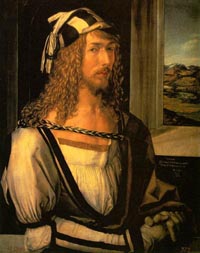 Beginning
in 1490 Durer travelled widely for study, including trips to Italy in
1494 and 1505-7 and to Antwerp and the Low Countries in 1520-1. During
his visit to Venice on his second Italian trip Durer was especially
influenced by Giovanni Bellini and Bellini's
brother-in-law Andrea Mantegna, each then
near the end of his career. In The Uffizi: A Guide to the Gallery
(Venice: Edizione Storti, 1980, p. 57) Umberto Fortis comments that
Durer's journeys enabled him "to fuse the Gothic traditions of the North
with the achievements in perspective, volumetric and plastic handling
of forms, and color of the Italians in an original synthesis which was
to have great influence with the Italian Mannerists."
Beginning
in 1490 Durer travelled widely for study, including trips to Italy in
1494 and 1505-7 and to Antwerp and the Low Countries in 1520-1. During
his visit to Venice on his second Italian trip Durer was especially
influenced by Giovanni Bellini and Bellini's
brother-in-law Andrea Mantegna, each then
near the end of his career. In The Uffizi: A Guide to the Gallery
(Venice: Edizione Storti, 1980, p. 57) Umberto Fortis comments that
Durer's journeys enabled him "to fuse the Gothic traditions of the North
with the achievements in perspective, volumetric and plastic handling
of forms, and color of the Italians in an original synthesis which was
to have great influence with the Italian Mannerists."
The period between his Italian trips was one of great productivity and
artistic growth, characterized by his publication, 1496-8, of a portfolio
of woodcuts, The Apocalypse of St. John. Scholars have suggested
that the portfolio may have been intended as a veiled expression of
support for the Reformation, with Babylon used as a surrogate for Rome.
 Beginning
at least as early as 1512, Durer became portraitist to the rich and
famous of his time, including Emperor Maximilian I, c. 1518, and Christian
II of Denmark, 1521. Other sitters included Jacob Fugger and other prominent
merchants, clergy and government officials. An early chalk and watercolor
portrait by Durer, 1494-5, appears
to copy Gentile Bellini's profile
painting, now lost, of Queen Caterina Cornaro
(B-31) following her surrender of her throne in Cyprus and retirement
to her native Venice. Shown here are Durer's own self-portraits at ages
22, 26 and 28 (now in the collections of the Louvre, Prado and Alte
Pinakothek of Munich).
Beginning
at least as early as 1512, Durer became portraitist to the rich and
famous of his time, including Emperor Maximilian I, c. 1518, and Christian
II of Denmark, 1521. Other sitters included Jacob Fugger and other prominent
merchants, clergy and government officials. An early chalk and watercolor
portrait by Durer, 1494-5, appears
to copy Gentile Bellini's profile
painting, now lost, of Queen Caterina Cornaro
(B-31) following her surrender of her throne in Cyprus and retirement
to her native Venice. Shown here are Durer's own self-portraits at ages
22, 26 and 28 (now in the collections of the Louvre, Prado and Alte
Pinakothek of Munich).
Durer expressed his theories on proportion in The Four Books on Human
Proportions, published posthumously in 1528.


